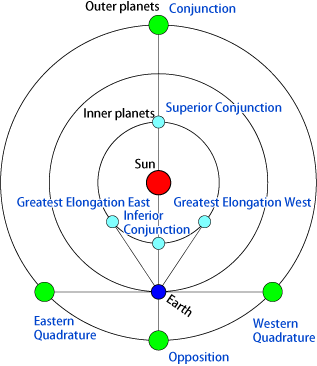Planetary Phenomena

Stationary
Stationary is the time when the time derivative of the right ascension of the planet becomes 0. The motion of the planet among the stars seems to stop and changes its direction when the planet reaches stationary.
Conjunction
Conjunction is the time when the geocentric longitude of the planet becomes identical to that of the Sun, in other words, when the planet locates in the same direction of the Sun. The inner planets, Mercury and Venus, have Inferior Conjunction when the planet is between the Earth and the Sun and Superior Conjunction when the planet is behind the Sun.
Greatest Elongation
Greatest Elongation is the time when the true angular distance between the Sun and the inner planet becomes extremes, in other words, when the inner planet seems to be farthest from the Sun. If the inner planet is in the east of the Sun as seen from the Earth, it is called Greatest Elongation East, and if it is in the west, it is called Greatest Elongation West. Greatest Elongation provides good opportunity for observers to see inner planets. Around Greatest Elongation East, the inner planet can be seen in the west sky after sunset, and around Greatest Elongation West, the inner planet can be seen in the east sky before sunrise. Venus is so bright and so easy to find that it received nicknames such as 宵の明星 (bright star in the evening) or 明けの明星 (bright star at dawn).
Quadrature
Eastern Quadrature and Western Quadrature is the time when the difference of geocentric longitude of the planet and the Sun reaches 90° and 270°, respectively. The Planets passes the meridian in the evening around Eastern Quadrature and in the morning around Western Quadrature.
Opposition
Opposition is the time when the difference of the geocentric longitude of the planet and the Sun reaches 180°, in other words, when the planet locates in the opposite direction of the Sun. Opposition provides good opportunity for observers to see outer planets, since outer planet reaches closest to the Earth, becomes brightest and can be seen for almost whole night. Since the shape of the orbit of Mars is highly elliptical, the minimum distance between Mars and Earth varies greatly. When the Mars is near perihelion at opposition, it is closer to the Earth. In fact, opposition of Mars in 2003 marks closest approach in so many years.
Elliptic Motion
Perihelion is the time when the planet reaches closest to the Sun and aphelion is the time when the planet reaches farthest from the Sun.
Ecliptic
Ecliptic Farthest North of planets is the time when latitude of the planet becomes largest and Ecliptic Farthest South of planets is the time when latitude of the planet becomes smallest.
Ecliptic Passage of planets is the time when the planet passes the Ecliptic.
Greatest Brilliancy
Greatest Brilliancy of Venus is the time when the brilliancy of the illuminated disk of Venus becomes maximum. Venus shines brightest around the time of Greatest Brilliancy.
Equatorial Farthest North / South, Equatorial Passage
Equatorial Farthest North is the time when the declination of the Moon becomes largest and Equatorial Farthest South is the time when the declination of the Moon becomes smallest. The Moon rises or sets from northernmost direction around Equatorial Farthest North and from southernmost direction around Equatorial Farthest South.
Equatorial Passage of the Moon is the time when the Moon passes the equator.
Perigee and Apogee of the Moon
Perigee is the time when the Moon reaches closest to the Earth and apogee is the time when the Moon reaches farthest from the Earth. The apparent diameter of the Moon is larger in perigees and smaller in apogees. The distance of the Moon is scaled by the mean Earth - Moon distance i.e. 384,400km.